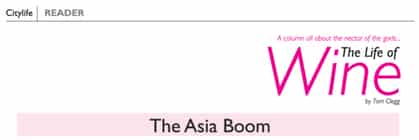
At the end of October last year, the canny marketing people at Chateau Lafite of the most sought after and most expensive wines on the planet – one announced that their 2008 vintage would go into bottles with the Chinese symbol for the number eight etched on the neck in red. The result was phenomenal. Customers in Hong Kong and China went nuts for it. It sold out everywhere, even though the price for a case of twelve bottles increased by more than £1,000 within a matter of hours.
This sort of overnight price hike is not necessarily unusual in the world of fine wine. Indeed, there is a man in America called Robert Parker who can controversially add hundreds to the price of a bottle by saying “Mmmmm, that’s really quite tasty, don’t you think?” He said it about the Lafite ’08 a few months earlier sending the price skyward along with a few bemused eyebrows.
Point is, on days like that day in October, the wine world is reminded of a shift in the balance of power from West to East. Punters in the emerging markets, especially China, appear to have decided that turning up at a friend’s cheese party with anything less than a decent vintage of first growth Bordeaux is just not on. That’s not to say that most Bordeaux isn’t still consumed in France, just that more of it is now to be found in our neck of the woods than ever before.
At wine expos around the world the subject on peoples’ lips is Asia. Moet Hennessey has just announced that it intends to produce Champagne style wines in the northwest of China as sales of the imported variety reportedly continue to grow in double digit figures.
Sotheby’s said recently that Hong Kong sales so far this year accounted for around 70 per cent of all wine sales conducted by the auction house. Hong Kong is now arguably more important than London and New York combined in terms of Bordeaux sales. A spokesman for Sotheby’s was quoted in the China Daily newspaper saying: “In 2011, it’s not just China. The whole of Asia – Japan, Indonesia, Singapore and Thailand – is driving sales.”
I’m not sure about Thailand yet. Outside of Bangkok and a few trendy nightspots in Chiang Mai the unquenchable lust for fine wine is still to take off. However, a quick look around the shelves of a shop like the Wine Gallery and it is quite obvious that there must be a few people hiding out in the north who are treating their dinner guests to something far more impressive than a glass of Blue Nun.
In an attempt to find out whether I would soon be receiving thousand pound bottles of wine from hosts wishing to do little more than show off I tried to find out why Lafite became so popular among China’s elite in the first place. One reason I came across was that the name is easy to pronounce, but that seems a bit silly. It’s more likely that like Rolex, it became a quickly recognisable, and trusted, luxury brand at a time when opening expensive wines as a sign of status began to take off.
There are now indications that China may be daring to move away from the usual big boys and looking to experiment with other Bordeaux growths _ to the point where some well known chateaus may soon be owned by not very French sounding conglomerates.
But is Thailand likely to follow suit?
As wine fever spreads from China, Hong Kong and Singapore, what can we expect in Thailand? Perhaps the authorities here will take notice and do something about the pricing system _ fine wine sales were given a leg-up in China after duty was binned in 2008. Perhaps people will stop comparing the alcohol content on a bottle of Sang Som and a bottle of Cabernet Sauvignon and considering it a no brainer to invest in the rum. Or perhaps some clever guy in Bordeaux will realise that carving a lucky number 9, a Garuda or a picture of Al Pacino onto the bottle might be the way ahead.
Ch. Lafite 2008: Around 60,000 baht per bottle before sales tax.
